2008 FIAT SEDICI brake light
[x] Cancel search: brake lightPage 165 of 266
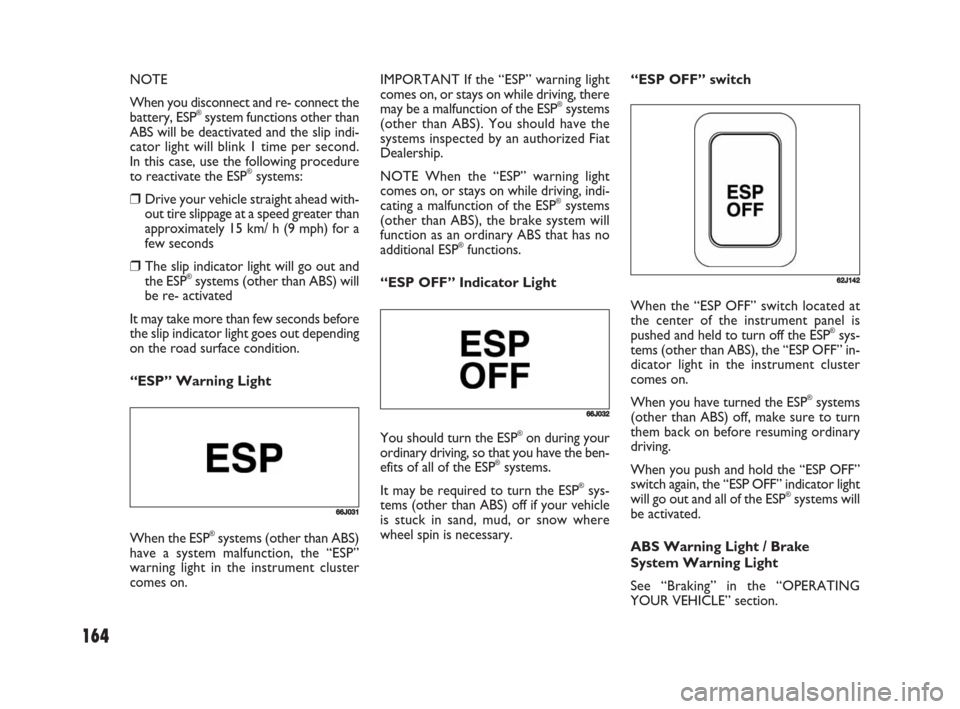
164
NOTE
When you disconnect and re- connect the
battery, ESP
®system functions other than
ABS will be deactivated and the slip indi-
cator light will blink 1 time per second.
In this case, use the following procedure
to reactivate the ESP
®systems:
❒Drive your vehicle straight ahead with-
out tire slippage at a speed greater than
approximately 15 km/ h (9 mph) for a
few seconds
❒The slip indicator light will go out and
the ESP®systems (other than ABS) will
be re- activated
It may take more than few seconds before
the slip indicator light goes out depending
on the road surface condition.
“ESP” Warning LightIMPORTANT If the “ESP” warning light
comes on, or stays on while driving, there
may be a malfunction of the ESP
®systems
(other than ABS). You should have the
systems inspected by an authorized Fiat
Dealership.
NOTE When the “ESP” warning light
comes on, or stays on while driving, indi-
cating a malfunction of the ESP
®systems
(other than ABS), the brake system will
function as an ordinary ABS that has no
additional ESP
®functions.
“ESP OFF” Indicator Light“ESP OFF” switch
When the “ESP OFF” switch located at
the center of the instrument panel is
pushed and held to turn off the ESP
®sys-
tems (other than ABS), the “ESP OFF” in-
dicator light in the instrument cluster
comes on.
When you have turned the ESP
®systems
(other than ABS) off, make sure to turn
them back on before resuming ordinary
driving.
When you push and hold the “ESP OFF”
switch again, the “ESP OFF” indicator light
will go out and all of the ESP
®systems will
be activated.
ABS Warning Light / Brake
System Warning Light
See “Braking” in the “OPERATING
YOUR VEHICLE” section.66J031
When the ESP®systems (other than ABS)
have a system malfunction, the “ESP”
warning light in the instrument cluster
comes on.
66J032
You should turn the ESP®on during your
ordinary driving, so that you have the ben-
efits of all of the ESP
®systems.
It may be required to turn the ESP
®sys-
tems (other than ABS) off if your vehicle
is stuck in sand, mud, or snow where
wheel spin is necessary.
62J142
149-166 Fiat16 New GB 3-09-2008 8:15 Pagina 164
Page 174 of 266
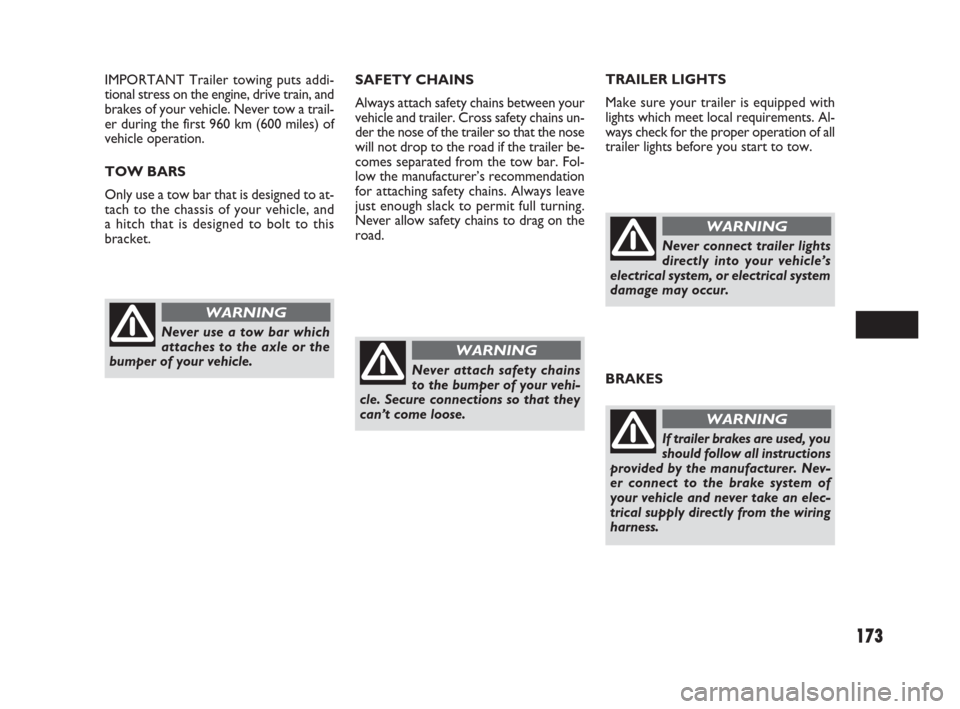
Never use a tow bar which
attaches to the axle or the
bumper of your vehicle.
WARNING
Never attach safety chains
to the bumper of your vehi-
cle. Secure connections so that they
can’t come loose.
WARNING
Never connect trailer lights
directly into your vehicle’s
electrical system, or electrical system
damage may occur.
WARNING
BRAKES
If trailer brakes are used, you
should follow all instructions
provided by the manufacturer. Nev-
er connect to the brake system of
your vehicle and never take an elec-
trical supply directly from the wiring
harness.
WARNING
173
SAFETY CHAINS
Always attach safety chains between your
vehicle and trailer. Cross safety chains un-
der the nose of the trailer so that the nose
will not drop to the road if the trailer be-
comes separated from the tow bar. Fol-
low the manufacturer’s recommendation
for attaching safety chains. Always leave
just enough slack to permit full turning.
Never allow safety chains to drag on the
road.TRAILER LIGHTS
Make sure your trailer is equipped with
lights which meet local requirements. Al-
ways check for the proper operation of all
trailer lights before you start to tow. IMPORTANT Trailer towing puts addi-
tional stress on the engine, drive train, and
brakes of your vehicle. Never tow a trail-
er during the first 960 km (600 miles) of
vehicle operation.
TOW BARS
Only use a tow bar that is designed to at-
tach to the chassis of your vehicle, and
a hitch that is designed to bolt to this
bracket.
171-180 Fiat16 New GB 3-09-2008 8:42 Pagina 173
Page 176 of 266
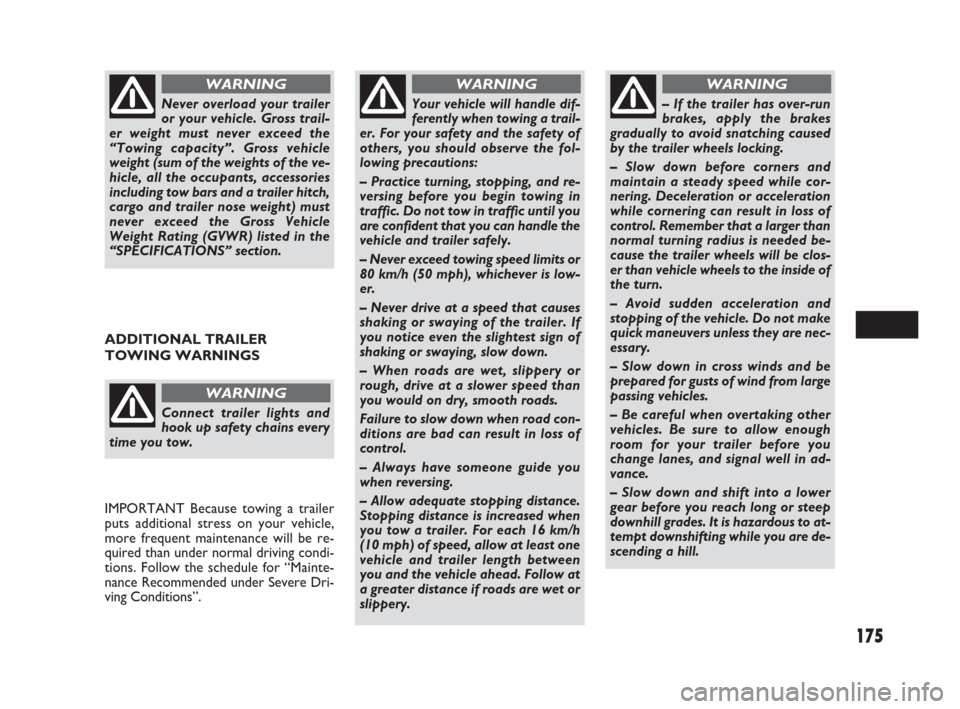
175
ADDITIONAL TRAILER
TOWING WARNINGS
Never overload your trailer
or your vehicle. Gross trail-
er weight must never exceed the
“Towing capacity”. Gross vehicle
weight (sum of the weights of the ve-
hicle, all the occupants, accessories
including tow bars and a trailer hitch,
cargo and trailer nose weight) must
never exceed the Gross Vehicle
Weight Rating (GVWR) listed in the
“SPECIFICATIONS” section.
WARNING
Connect trailer lights and
hook up safety chains every
time you tow.
WARNING
IMPORTANT Because towing a trailer
puts additional stress on your vehicle,
more frequent maintenance will be re-
quired than under normal driving condi-
tions. Follow the schedule for “Mainte-
nance Recommended under Severe Dri-
ving Conditions”.
Your vehicle will handle dif-
ferently when towing a trail-
er. For your safety and the safety of
others, you should observe the fol-
lowing precautions:
– Practice turning, stopping, and re-
versing before you begin towing in
traffic. Do not tow in traffic until you
are confident that you can handle the
vehicle and trailer safely.
– Never exceed towing speed limits or
80 km/h (50 mph), whichever is low-
er.
– Never drive at a speed that causes
shaking or swaying of the trailer. If
you notice even the slightest sign of
shaking or swaying, slow down.
– When roads are wet, slippery or
rough, drive at a slower speed than
you would on dry, smooth roads.
Failure to slow down when road con-
ditions are bad can result in loss of
control.
– Always have someone guide you
when reversing.
– Allow adequate stopping distance.
Stopping distance is increased when
you tow a trailer. For each 16 km/h
(10 mph) of speed, allow at least one
vehicle and trailer length between
you and the vehicle ahead. Follow at
a greater distance if roads are wet or
slippery.
WARNING
– If the trailer has over-run
brakes, apply the brakes
gradually to avoid snatching caused
by the trailer wheels locking.
– Slow down before corners and
maintain a steady speed while cor-
nering. Deceleration or acceleration
while cornering can result in loss of
control. Remember that a larger than
normal turning radius is needed be-
cause the trailer wheels will be clos-
er than vehicle wheels to the inside of
the turn.
– Avoid sudden acceleration and
stopping of the vehicle. Do not make
quick maneuvers unless they are nec-
essary.
– Slow down in cross winds and be
prepared for gusts of wind from large
passing vehicles.
– Be careful when overtaking other
vehicles. Be sure to allow enough
room for your trailer before you
change lanes, and signal well in ad-
vance.
– Slow down and shift into a lower
gear before you reach long or steep
downhill grades. It is hazardous to at-
tempt downshifting while you are de-
scending a hill.
WARNING
171-180 Fiat16 New GB 3-09-2008 8:42 Pagina 175
Page 185 of 266
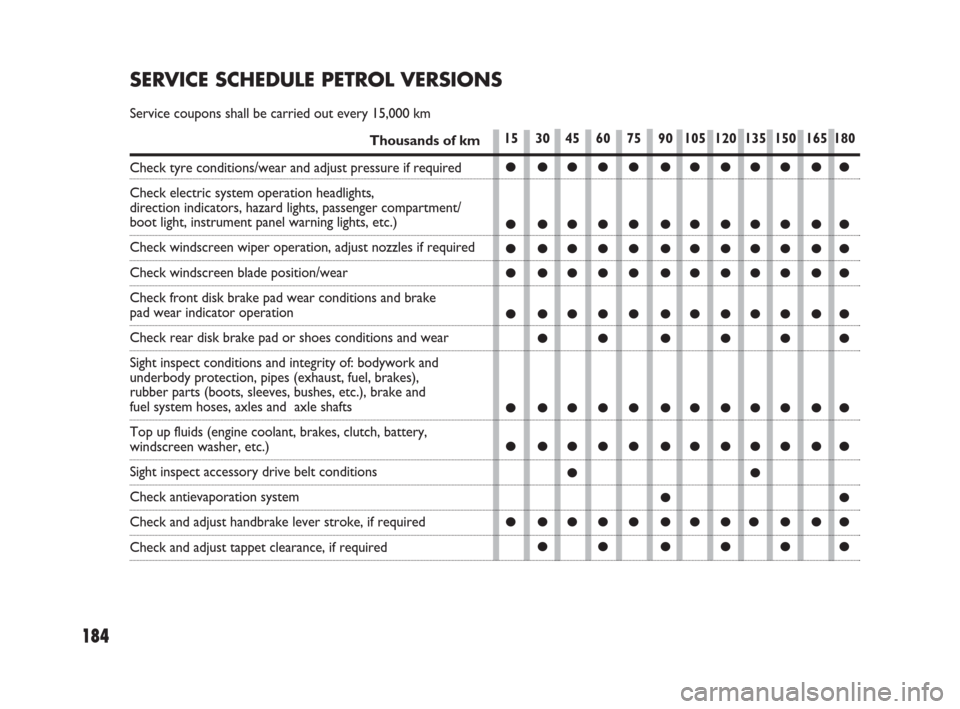
184
15 30 45 60 75 90 105 120 135 150 165 180
●●●●●●●●●●●●
●●●●●●●●●●●●
●●●●●●●●●●●●
●●●●●●●●●●●●
●●●●●●●●●●●●
●● ●●●●
●●●●●●●●●●●●
●●●●●●●●●●●●
●●
●●
●●●●●●●●●●●●
●● ●●●●
SERVICE SCHEDULE PETROL VERSIONS
Service coupons shall be carried out every 15,000 km
Thousands of km
Check tyre conditions/wear and adjust pressure if required
Check electric system operation headlights,
direction indicators, hazard lights, passenger compartment/
boot light, instrument panel warning lights, etc.)
Check windscreen wiper operation, adjust nozzles if required
Check windscreen blade position/wear
Check front disk brake pad wear conditions and brake
pad wear indicator operation
Check rear disk brake pad or shoes conditions and wear
Sight inspect conditions and integrity of: bodywork and
underbody protection, pipes (exhaust, fuel, brakes),
rubber parts (boots, sleeves, bushes, etc.), brake and
fuel system hoses, axles and axle shafts
Top up fluids (engine coolant, brakes, clutch, battery,
windscreen washer, etc.)
Sight inspect accessory drive belt conditions
Check antievaporation system
Check and adjust handbrake lever stroke, if required
Check and adjust tappet clearance, if required
181-224 Fiat16 New GB 3-09-2008 8:17 Pagina 184
Page 187 of 266
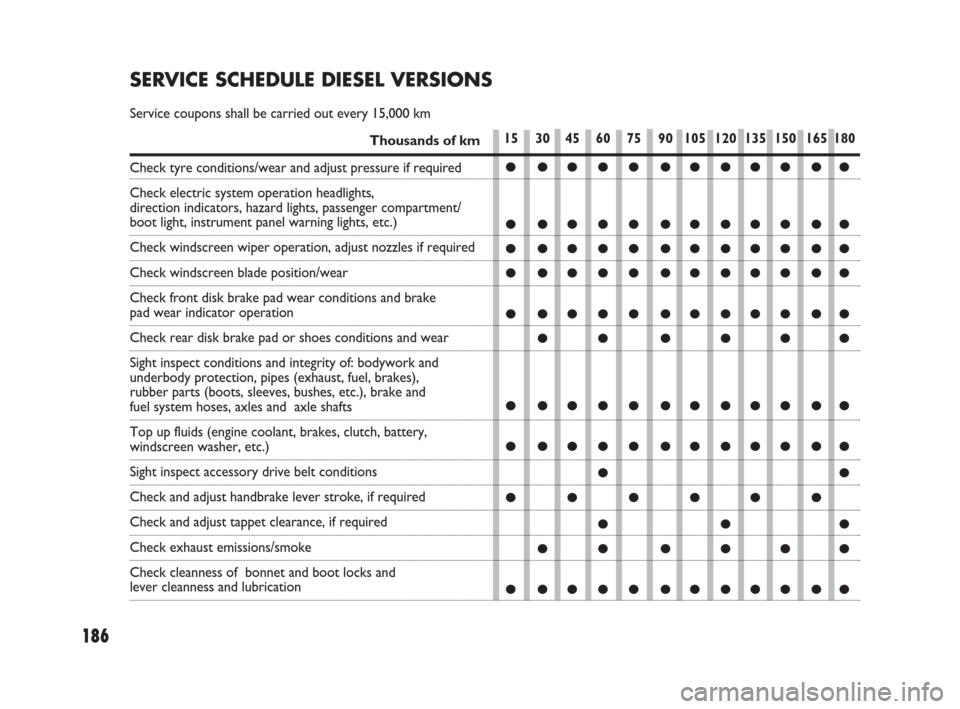
186
15 30 45 60 75 90 105 120 135 150 165 180
●●●●●●●●●●●●
●●●●●●●●●●●●
●●●●●●●●●●●●
●●●●●●●●●●●●
●●●●●●●●●●●●
●● ●●●●
●●●●●●●●●●●●
●●●●●●●●●●●●
●●
●●●●●●
●●●
●● ●●●●
●●●●●●●●●●●●
SERVICE SCHEDULE DIESEL VERSIONS
Service coupons shall be carried out every 15,000 km
Thousands of km
Check tyre conditions/wear and adjust pressure if required
Check electric system operation headlights,
direction indicators, hazard lights, passenger compartment/
boot light, instrument panel warning lights, etc.)
Check windscreen wiper operation, adjust nozzles if required
Check windscreen blade position/wear
Check front disk brake pad wear conditions and brake
pad wear indicator operation
Check rear disk brake pad or shoes conditions and wear
Sight inspect conditions and integrity of: bodywork and
underbody protection, pipes (exhaust, fuel, brakes),
rubber parts (boots, sleeves, bushes, etc.), brake and
fuel system hoses, axles and axle shafts
Top up fluids (engine coolant, brakes, clutch, battery,
windscreen washer, etc.)
Sight inspect accessory drive belt conditions
Check and adjust handbrake lever stroke, if required
Check and adjust tappet clearance, if required
Check exhaust emissions/smoke
Check cleanness of bonnet and boot locks and
lever cleanness and lubrication
181-224 Fiat16 New GB 3-09-2008 8:17 Pagina 186
Page 188 of 266

187
15 30 45 60 75 90 105 120 135 150 165 180
(●)(●)(●)(●)(●)(●)
●● ●● ●● ●●
●●●●
●●●●
●
●
●●●
●●●●
●
●●●●
●●●●●●
●●●●●
●
●● ●●●●
●● ●●●●
●● ●●●●
●● ●●●●
● ●●●● ●●●●●●●
Thousands of km
Change engine oil and oil filter (Diesel versions - DPF)**
Check air cleaner conditions
Replace air cleaner cartridge
Change engine coolant
Change accessory drive belt conditions
Change timing belt *
Change fuel filter
Sight inspect fuel tank conditions
Check manual transaxle gear oil level
Change manual transaxle gear oil
Check transmission unit oil level (4x4 version)
Check rear differential oil level (4x4 version)
Change rear differential oil (4x4 version)
(just the first time at 15,000 km)
Check suspension operation
Check steering system (electric drive)
Check engine control system operation
(through diagnostic socket)
Change brake and clutch fluid (or every 2 years)
Change pollen filter (or every 2 years)
* Or every 4 years in the event of particularly demanding use (cold climates, driving in the city, idling for a long time, driving on dusty
roads or covered with sand and/or salt), or in any case every 5 years regardless of the km covered.
** Actual interval to change engine oil and oil filter depends on the conditions of use of the vehicle and it is indicated by the relevant in-
strument panel warning light (see section “Warning and indicator lights”), or in any case every 2 years.
181-224 Fiat16 New GB 3-09-2008 8:17 Pagina 187
Page 203 of 266
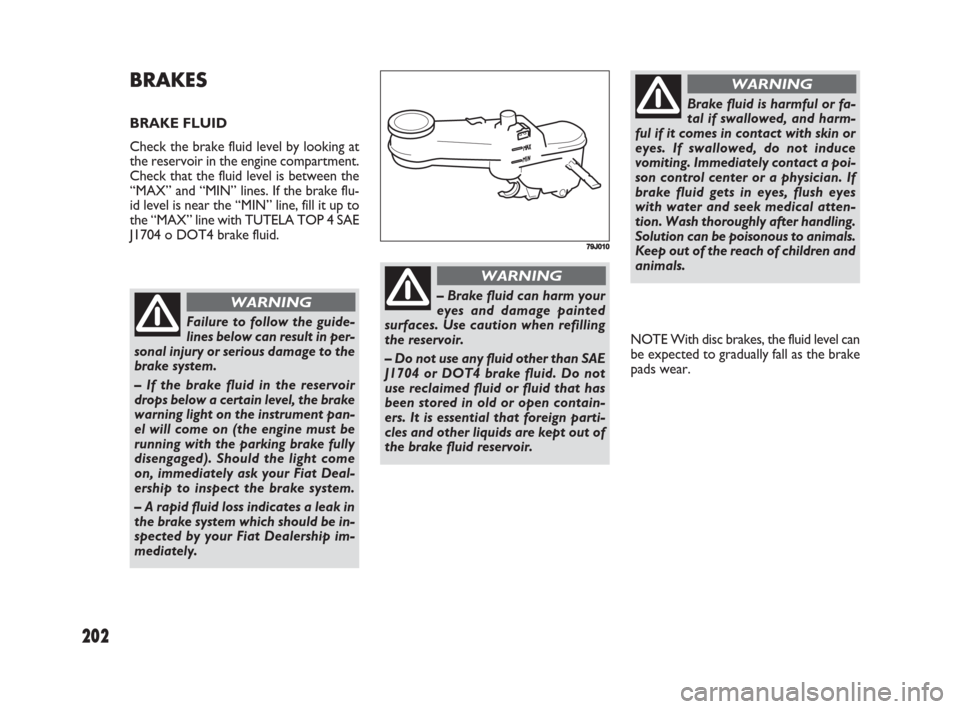
202
NOTE With disc brakes, the fluid level can
be expected to gradually fall as the brake
pads wear.
BRAKES
BRAKE FLUID
Check the brake fluid level by looking at
the reservoir in the engine compartment.
Check that the fluid level is between the
“MAX” and “MIN” lines. If the brake flu-
id level is near the “MIN” line, fill it up to
the “MAX” line with TUTELA TOP 4 SAE
J1704 o DOT4 brake fluid.
79J010
Failure to follow the guide-
lines below can result in per-
sonal injury or serious damage to the
brake system.
– If the brake fluid in the reservoir
drops below a certain level, the brake
warning light on the instrument pan-
el will come on (the engine must be
running with the parking brake fully
disengaged). Should the light come
on, immediately ask your Fiat Deal-
ership to inspect the brake system.
– A rapid fluid loss indicates a leak in
the brake system which should be in-
spected by your Fiat Dealership im-
mediately.
WARNING– Brake fluid can harm your
eyes and damage painted
surfaces. Use caution when refilling
the reservoir.
– Do not use any fluid other than SAE
J1704 or DOT4 brake fluid. Do not
use reclaimed fluid or fluid that has
been stored in old or open contain-
ers. It is essential that foreign parti-
cles and other liquids are kept out of
the brake fluid reservoir.
WARNING
Brake fluid is harmful or fa-
tal if swallowed, and harm-
ful if it comes in contact with skin or
eyes. If swallowed, do not induce
vomiting. Immediately contact a poi-
son control center or a physician. If
brake fluid gets in eyes, flush eyes
with water and seek medical atten-
tion. Wash thoroughly after handling.
Solution can be poisonous to animals.
Keep out of the reach of children and
animals.
WARNING
181-224 Fiat16 New GB 3-09-2008 8:18 Pagina 202
Page 205 of 266
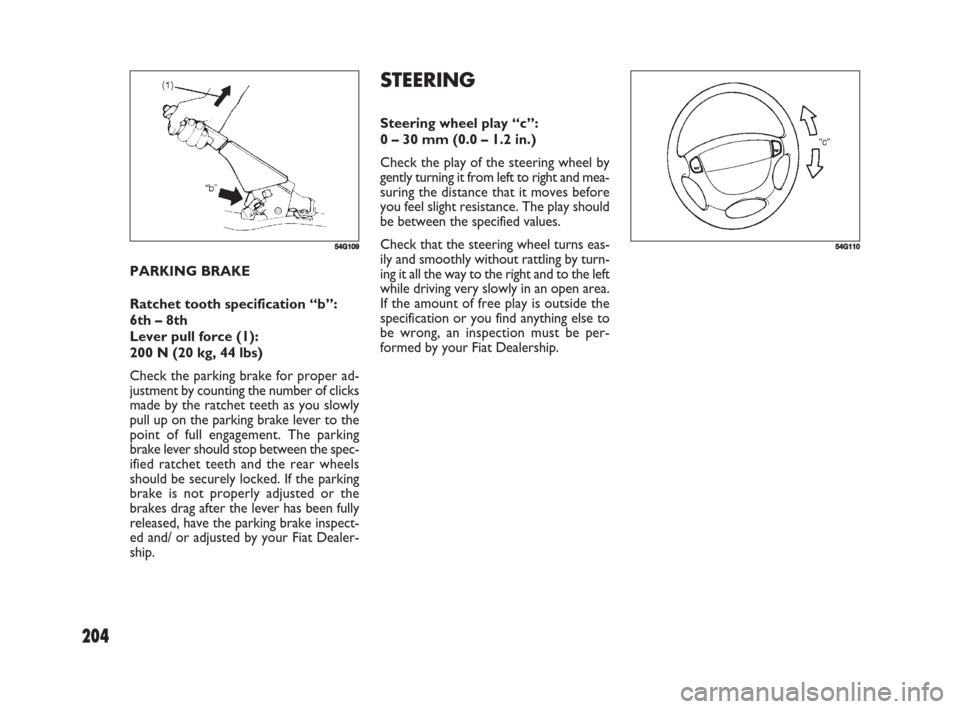
204
STEERING
Steering wheel play “c”:
0 – 30 mm (0.0 – 1.2 in.)
Check the play of the steering wheel by
gently turning it from left to right and mea-
suring the distance that it moves before
you feel slight resistance. The play should
be between the specified values.
Check that the steering wheel turns eas-
ily and smoothly without rattling by turn-
ing it all the way to the right and to the left
while driving very slowly in an open area.
If the amount of free play is outside the
specification or you find anything else to
be wrong, an inspection must be per-
formed by your Fiat Dealership. PARKING BRAKE
Ratchet tooth specification “b”:
6th – 8th
Lever pull force (1):
200 N (20 kg, 44 lbs)
Check the parking brake for proper ad-
justment by counting the number of clicks
made by the ratchet teeth as you slowly
pull up on the parking brake lever to the
point of full engagement. The parking
brake lever should stop between the spec-
ified ratchet teeth and the rear wheels
should be securely locked. If the parking
brake is not properly adjusted or the
brakes drag after the lever has been fully
released, have the parking brake inspect-
ed and/ or adjusted by your Fiat Dealer-
ship.
54G10954G110
181-224 Fiat16 New GB 3-09-2008 8:18 Pagina 204